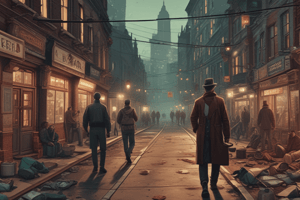Podcast
Questions and Answers
What dominated criminology theorizing until the Great Depression?
What dominated criminology theorizing until the Great Depression?
- Sociological explanations
- Strain perspective
- Biological determinism (correct)
- Learning perspective
Which perspective focuses on institutional power imbalance in society?
Which perspective focuses on institutional power imbalance in society?
- Social disorganization perspective
- Critical perspective
- Feminist perspective
- Institutional anomie theory (correct)
What does collective efficacy by Sampson refer to?
What does collective efficacy by Sampson refer to?
- The ability of residents to act for the common good of the neighborhood (correct)
- The ability of residents to identify criminal opportunities in the neighborhood
- The ability of the police to control crime in the neighborhood
- The ability of residents to form delinquent subcultures
What is the focus of General strain theory by Robert Agnew?
What is the focus of General strain theory by Robert Agnew?
What does Anderson's Code of the Street theory suggest?
What does Anderson's Code of the Street theory suggest?
Which theory suggests that people in the working class are often surrounded by criminal opportunities in the neighborhood?
Which theory suggests that people in the working class are often surrounded by criminal opportunities in the neighborhood?
What are the two major learning theories discussed in the text?
What are the two major learning theories discussed in the text?
What did Hagan apply to criminology?
What did Hagan apply to criminology?
What are the critiques of subcultural theories?
What are the critiques of subcultural theories?
What are important factors in delinquent behavior?
What are important factors in delinquent behavior?
What is Miller's Theory of Focal Concerns?
What is Miller's Theory of Focal Concerns?
Flashcards are hidden until you start studying
Study Notes
- Biological determinism dominated criminology theorizing until the Great Depression.
- Sociological explanations emerged in the 1930s.
- Strain perspective, social disorganization perspective, learning perspective, modern classical perspective, critical, conflict, and feminist perspective, and life-course perspective are sociological explanations.
- Strain theory by Robert Merton is a class-based theory of crime.
- General strain theory by Robert Agnew focuses on how negative emotions can lead to crime.
- Institutional anomie theory by Messner and Rosenfeld focuses on institutional power imbalance in society.
- Social disorganization perspective focuses on characteristics of environments associated with high crime rates.
- Collective efficacy by Sampson refers to cohesion among residents and their ability to act for the common good of the neighborhood.
- Learning theories include classical conditioning, operant conditioning, and social learning.
- Differential association by Sutherland and social learning theory by Akers are two major learning theories.
- The text discusses subcultural theories of juvenile delinquency.
- Cohen's Theory of Blocked Opportunity suggests that working-class youth turn to delinquent subcultures when they encounter blocked opportunities to achieve status and respect in conventional society.
- Miller's Theory of Focal Concerns suggests that lower-class values, such as trouble and toughness, are the cause of high delinquency.
- Cloward and Ohlin's theory suggests that people in the working class are often surrounded by criminal opportunities in the neighborhood, leading to the development of delinquent subcultures.
- Wolfgang and Ferracuti's Subculture of Violence theory suggests that there is a subculture among working-class Black males that promotes the use of violence.
- Anderson's Code of the Street theory suggests that there is a street subculture in Black, urban communities that places emphasis on respect and accepts violence as a way to stand up against disrespect.
- Hagan applied the idea of social embeddedness to criminology, arguing that people can be socially embedded in criminal networks.
- Critiques of subcultural theories include their limitations in explaining delinquent behavior in all working-class youth and their neglect of the role of police in targeting young working-class people.
- Definitions and differential reinforcement are important factors in delinquent behavior.
- Associations with delinquent friends are strong predictors of delinquent behavior.
Studying That Suits You
Use AI to generate personalized quizzes and flashcards to suit your learning preferences.




